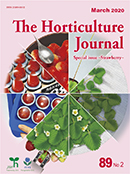Volume 89, Issue 2
Displaying 1-12 of 12 articles from this issue
- |<
- <
- 1
- >
- >|
PREFACE
-
Article type: Preface
2020Volume 89Issue 2 Pages 85
Published: 2020
Released on J-STAGE: April 06, 2020
Download PDF (153K) Full view HTML
INVITED REVIEWS
-
Article type: Invited Review
2020Volume 89Issue 2 Pages 87-95
Published: 2020
Released on J-STAGE: April 06, 2020
Download PDF (888K) Full view HTML -
Article type: Invited Review
2020Volume 89Issue 2 Pages 96-107
Published: 2020
Released on J-STAGE: April 06, 2020
Download PDF (4406K) Full view HTML -
Article type: Invited Review
2020Volume 89Issue 2 Pages 108-114
Published: 2020
Released on J-STAGE: April 06, 2020
Download PDF (1145K) Full view HTML -
Article type: Invited Review
2020Volume 89Issue 2 Pages 115-123
Published: 2020
Released on J-STAGE: April 06, 2020
Download PDF (1748K) Full view HTML
REVIEW
-
Article type: Review
2020Volume 89Issue 2 Pages 124-137
Published: 2020
Released on J-STAGE: April 06, 2020
Advance online publication: March 11, 2020Download PDF (2486K) Full view HTML
ORIGINAL ARTICLES
-
Article type: Original Articles
2020Volume 89Issue 2 Pages 138-146
Published: 2020
Released on J-STAGE: April 06, 2020
Advance online publication: February 21, 2020Download PDF (1229K) Full view HTML -
Article type: Original Articles
2020Volume 89Issue 2 Pages 147-160
Published: 2020
Released on J-STAGE: April 06, 2020
Advance online publication: February 26, 2020Download PDF (1079K) Full view HTML -
Article type: Original Articles
2020Volume 89Issue 2 Pages 161-166
Published: 2020
Released on J-STAGE: April 06, 2020
Download PDF (709K) Full view HTML -
Article type: Original Articles
2020Volume 89Issue 2 Pages 167-174
Published: 2020
Released on J-STAGE: April 06, 2020
Advance online publication: March 10, 2020Download PDF (485K) Full view HTML -
Article type: Original Articles
2020Volume 89Issue 2 Pages 175-181
Published: 2020
Released on J-STAGE: April 06, 2020
Advance online publication: December 17, 2019Download PDF (547K) Full view HTML -
Article type: Original Articles
2020Volume 89Issue 2 Pages 182-190
Published: 2020
Released on J-STAGE: April 06, 2020
Advance online publication: March 05, 2020Download PDF (864K) Full view HTML
- |<
- <
- 1
- >
- >|
